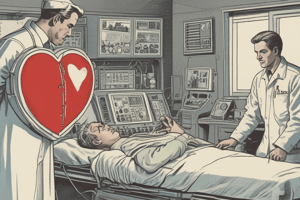Podcast
Questions and Answers
Which factor regulates the circulation of fluid between capillaries and interstitial tissue?
Which factor regulates the circulation of fluid between capillaries and interstitial tissue?
- Lymphatic system (correct)
- Blood viscosity
- Blood pressure
- Heart rate
What is the major complication of venous thrombi?
What is the major complication of venous thrombi?
- Hypertension
- Coronary heart disease
- Pulmonary embolism (correct)
- Atherosclerosis
What are the causes of arterial thrombosis?
What are the causes of arterial thrombosis?
- Atherosclerosis (correct)
- Low blood pressure
- High blood viscosity
- Lymphatic obstruction
What is the natural history of atherosclerosis?
What is the natural history of atherosclerosis?
What is the main factor leading to shock?
What is the main factor leading to shock?
What factors can interfere with circulation?
What factors can interfere with circulation?
What can lead to poor nutrition of the tissues served by the veins?
What can lead to poor nutrition of the tissues served by the veins?
What are predisposing factors to clot formation in leg veins?
What are predisposing factors to clot formation in leg veins?
What can venous thrombosis commonly present with?
What can venous thrombosis commonly present with?
What can large pulmonary emboli lead to?
What can large pulmonary emboli lead to?
What is the most important test for diagnosing pulmonary embolism?
What is the most important test for diagnosing pulmonary embolism?
Which condition can lead to the obstruction of pulmonary capillaries following severe bone fractures?
Which condition can lead to the obstruction of pulmonary capillaries following severe bone fractures?
What can cause edema?
What can cause edema?
What can acute pulmonary edema result from?
What can acute pulmonary edema result from?
How can air embolism occur?
How can air embolism occur?
Which lipid is derived from ingested fat, sugar, and carbohydrates?
Which lipid is derived from ingested fat, sugar, and carbohydrates?
What is the sulfur-containing amino acid associated with severe atherosclerosis and increased cardiovascular disease risk?
What is the sulfur-containing amino acid associated with severe atherosclerosis and increased cardiovascular disease risk?
Which lipoprotein is associated with transporting high levels of blood lipids linked to premature atherosclerosis?
Which lipoprotein is associated with transporting high levels of blood lipids linked to premature atherosclerosis?
What type of hypertension can result from known diseases such as autoimmunity, chronic kidney disease, or hyperthyroidism?
What type of hypertension can result from known diseases such as autoimmunity, chronic kidney disease, or hyperthyroidism?
1
1
What is the main cause of arterial thrombosis?
What is the main cause of arterial thrombosis?
What factor does not contribute to arterial thrombosis?
What factor does not contribute to arterial thrombosis?
What predisposes patients with cancer to arterial and venous thromboses?
What predisposes patients with cancer to arterial and venous thromboses?
Study Notes
Manifestations and Pathogenesis of Cardiovascular Disorders
- Circulatory disturbances can lead to shock, categorized as hypovolemic, cardiogenic, septic, or anaphylactic shock.
- Shock occurs when blood flow or pressure is too low to adequately supply the body with blood, potentially life-threatening.
- Prognosis of shock depends on early recognition and rapid, appropriate treatment.
- Arterial thrombosis is mainly caused by injury to the vessel wall from arteriosclerosis, leading to infarct in different arteries such as the coronary, major leg, and cerebral arteries.
- Stasis is not a factor in arterial thrombosis due to rapid blood flow and high intravascular pressure.
- Intracardiac thrombosis may dislodge into systemic circulation and cause infarction in major organs.
- Thrombosis can be caused by increased coagulability due to factors such as polycythemia, estrogen in contraceptive pills, hereditary gene mutations, and rise in coagulation factors following surgery or injury.
- Patients with cancer are predisposed to both arterial and venous thromboses due to hypercoagulability from the rapid release of thromboplastic materials into circulation from the tumor.
- Arteriosclerosis is a chronic and progressive degenerative disease of large to mid-sized arteries, leading to atheroma formation and eventual stenosis with turbulent flow.
- Atheromatous deposits in arteries lead to narrowing and eventual stenosis with turbulent flow, causing damage and potential clot formation.
- Risk factors for atherosclerosis include elevated blood lipids, high blood pressure, smoking, diabetes, and genetic predisposition.
- Genetic predisposition has the largest impact on atherosclerosis, accounting for 40-60% of the risk.
Studying That Suits You
Use AI to generate personalized quizzes and flashcards to suit your learning preferences.
Related Documents
Description
Explore the manifestations and pathogenesis of cardiovascular disorders, including circulatory disturbances, shock, arterial thrombosis, intracardiac thrombosis, and atheromatous deposits in arteries. Understand the risk factors and prognosis associated with these conditions.





